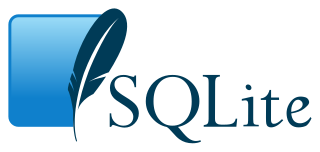
The mkdir command in the Unix, DOS, DR FlexOS, IBM OS/2, Microsoft Windows, and ReactOS operating systems is used to make a new directory. It is also available in the EFI shell and in the PHP scripting language. In DOS, OS/2, Windows and ReactOS, the command is often abbreviated to md.
In computing, a symbolic link is a term for any file that contains a reference to another file or directory in the form of an absolute or relative path and that affects pathname resolution.

SQLite is a database engine, written in the C language. It is not a standalone app; rather, it is a library that software developers embed in their apps. As such, it belongs to the family of embedded databases. It is the most widely deployed database engine, as it is used by several of the top web browsers, operating systems, mobile phones, and other embedded systems.
Trac is an open-source, web-based project management and bug tracking system. It has been adopted by a variety of organizations for use as a bug tracking system for both free and open-source software and proprietary projects and products. Trac integrates with major version control systems including Subversion and Git. Trac is used, among others, by the Internet Research Task Force, Django, FFmpeg, jQuery UI, WebKit, 0 A.D., and WordPress.
The SQL SELECT statement returns a result set of records, from one or more tables.
Maven is a build automation tool used primarily for Java projects. Maven can also be used to build and manage projects written in C#, Ruby, Scala, and other languages. The Maven project is hosted by the Apache Software Foundation, where it was formerly part of the Jakarta Project.
In Unix-like and some other operating systems, find is a command-line utility that locates files based on some user-specified criteria and either prints the pathname of each matched object or, if another action is requested, performs that action on each matched object.
The following tables compare general and technical information for a number of relational database management systems. Please see the individual products' articles for further information. Unless otherwise specified in footnotes, comparisons are based on the stable versions without any add-ons, extensions or external programs.
Remote File Sharing (RFS) is a Unix operating system component for sharing resources, such as files, devices, and file system directories, across a network, in a network-independent manner, similar to a distributed file system. It was developed at Bell Laboratories of AT&T in the 1980s, and was first delivered with UNIX System V Release 3 (SVR3). RFS relied on the STREAMS Transport Provider Interface feature of this operating system. It was also included in UNIX System V Release 4, but as that also included the Network File System (NFS) which was based on TCP/IP and more widely supported in the computing industry, RFS was little used. Some licensees of AT&T UNIX System V Release 4 did not include RFS support in SVR4 distributions, and Sun Microsystems removed it from Solaris 2.4.
The following is a comparison of version-control software. The following tables include general and technical information on notable version control and software configuration management (SCM) software. For SCM software not suitable for source code, see Comparison of open-source configuration-management software.
The NTFS file system defines various ways to redirect files and folders, e.g., to make a file point to another file or its contents. The object being pointed to is called the target. There are three classes of links:

Serendipity is a blog and web-based content management system written in PHP and available under a BSD license. It supports PostgreSQL, MySQL, SQLite database backends, the Smarty template engine, and a plugin architecture for user contributed modifications.
The Doctrine Project is a set of PHP libraries primarily focused on providing persistence services and related functionality. Its prize projects are an object–relational mapper (ORM) and the database abstraction layer it is built on top of.
A hierarchical query is a type of SQL query that handles hierarchical model data. They are special cases of more general recursive fixpoint queries, which compute transitive closures.
Web2py is an open-source web application framework written in the Python programming language. Web2py allows web developers to program dynamic web content using Python. Web2py is designed to help reduce tedious web development tasks, such as developing web forms from scratch, although a web developer may build a form from scratch if required.

PhpStorm is a proprietary, cross-platform IDE for PHP, built by the Czech Republic-based company JetBrains.

TACTIC is a web-based, open source workflow platform and digital asset management system supported by Southpaw Technology in Toronto, ON. Designed to optimize busy production environments with high volumes of content traffic, TACTIC applies business or workflow logic to combined database and file system management. Using elements of digital asset management, production asset management and workflow management, TACTIC tracks the creation and development of digital assets through production pipelines. TACTIC is available under both commercial and open-source licenses, and also as a hosted cloud service through Amazon Web Services Marketplace.
The following is provided as an overview of and topical guide to databases:

Apache Drill is an open-source software framework that supports data-intensive distributed applications for interactive analysis of large-scale datasets. Built chiefly by contributions from developers from MapR, Drill is inspired by Google's Dremel system, also productized as BigQuery. Drill is an Apache top-level project.
The syntax of the SQL programming language is defined and maintained by ISO/IEC SC 32 as part of ISO/IEC 9075. This standard is not freely available. Despite the existence of the standard, SQL code is not completely portable among different database systems without adjustments.






